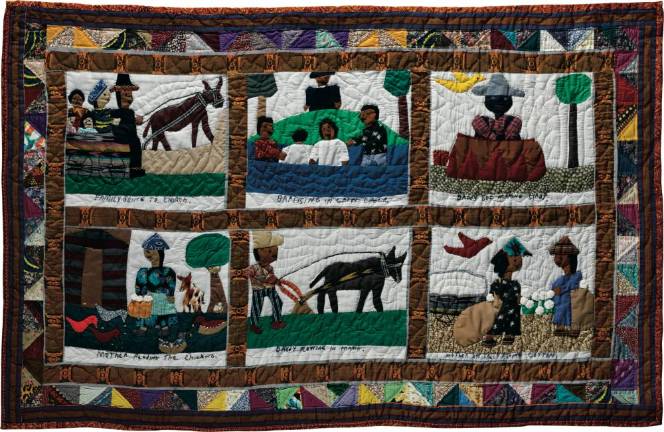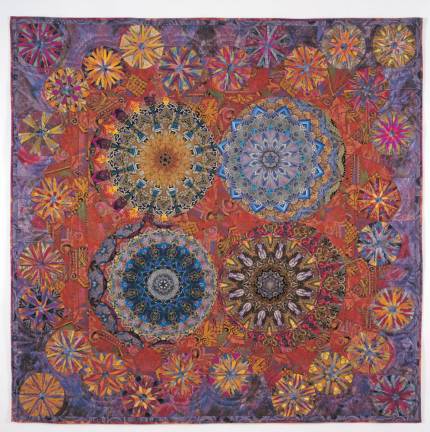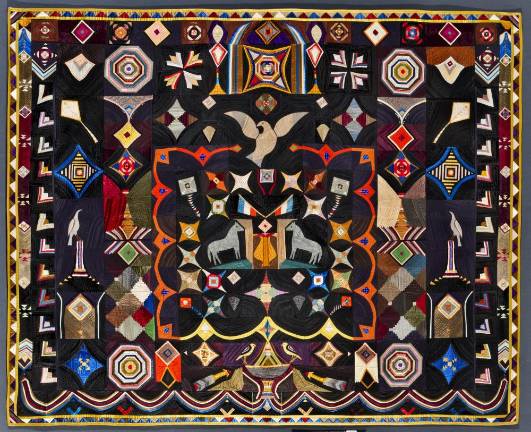Exhibits of Quilt Tell Riveting Back Stories at Folk Museum
The American Folk Art Museum’s “What that Quilt says about me” run through Oct 29th. The backstories behind the colorful squares offers a patchwork of American history.



There’s much more to quilting than squares of fabric, and the proof is at the American Folk Art Museum.
Drawn from the museum’s collection of some 600 quilts, the show (which runs until October 29) offers patchwork quilts made from scraps of fabric, whole cloth quilts embellished with fanciful embroidery, and “quilt-adjacent” works that use condom wrappers, photos or kimono fabric. The 35 works on display–from the 19th century to the 21st–are an eye popping combination of technical artistry, history, and storytelling. In fact, says co-curator Emilie Gevalt, curatorial Chair for Collections and Curator of Folk Art, the show is called “What That Quilt Knows About Me’ and it is organized not chronologically or by technique but by their stories or backstories.
From the 19th century wedding quilt that took 20 years and 31,000 pieces of fabric, to a family album quilt detailing life on the farm, from the restrained (and strangely modern) geometric quilts of the Amish to the exuberant and whimsical retelling of Biblical stories or Greek myths, this show shows how far human creativity and expression can go with cloth, a needle and thread.
Why Quilts Matter
The mission of the show, Gevalt says, is to prove that quilts really are art objects. “It’s under-represented as an art form because of the context–it’s made by females–but it’s really a vibrant medium,” she says. Even today, the staid and spare quilts still made by Amish women, scattered throughout the show, could have come from the studio of a Mondrian. The show features spectacular–almost psychedelic works by modern artists like Paula Nadelstern’s Kaleidoscopic xvi: More is More, a series of trippy, mandala-like designs she painstakingly hand stitched on her kitchen table in Brooklyn. Japanese artist Setsuko Obi’s “Light from Far Away Space” is a dreamlike galaxy sprinkled with stars. A closer look reveals that the pieces of cloth (salvaged from vintage kimonos) are folded like origami and carefully stitched together.
But Gevalt says, long before museum shows, quilts were always display objects, with special ones saved for guests, or entered in state fairs–like the Sacred Bible quilts made by a woman in Georgia. Some quilts were to raise money. “You pay your nickel or dime and get your name on a square, and then the quilt would be raffled off to buy the church a new boiler” Gevalt says. (Even now, ‘quilt bingo” is a popular fund raiser in many communities.)
Stories in cloth
The exhibit is split into themed rooms, but of all the sections, the most compelling is the Narrative Threads room. After all, Gevalt says, “We picked quilts with the most compelling stories.” Each work tells its story in bits of silk or cotton or taffeta, embellished by stitchery. The narratives range from Biblical to pagan, from a family album of life on a farm to a triumphant wedding quilt.
For instance, the Homespun Untitled Family History quilt by Hystercine Rankin (1929–2010) is a poignant family album quilt of life on the farm, told in simple panels with an embroidered captions like “Mother and Sally picking Cotton” or “Daddy Joe making syrup.” In 1997 she received a National Heritage Fellowship from the National Endowment for the Arts.
On the other end of the spectrum, the Greek Myths quilt by Dr. Raymond F. Bellamy, a Florida college professor skilled in needlework, is more like a series of one panel comics with snarky embroidered commentary. (A spider with a woman’s head has the caption “Well anyway, Ariadne, you won that spinning contest.”) Nearby a Noah’s Ark quilt shows a fanciful parade of animals, insects, and Noah’s family arranged around the ark.
The Backstories
Almost as compelling as the stories are the backstories of the quilts. The beautiful Whig Rose and Swag Border quilt, with its complex needlework designs, was a case of mistaken identity until recently. A note pinned on its back revealed that the true creators were a pair of enslaved sisters in Antebellum Kentucky.
The beautiful Wedding Quilt by German Immigrant tailor Carl Klewicke (1835-1913) is a show-stopping, jubilant composition of birds, fountains, flowers and stars with near stained glass vibrance. Composed of some 31,000 pieces of silk, taffeta, faille and satin remnants gleaned from fabric remnants, Klewicke started this quilt when a baby girl was left on his doorstep in Corning. His family adopted the child and he spent the next 20 years working on the quilt to give her on her wedding day.
Reinventing tradition
The most modern of the themes, “Reinventing Tradition” explores contemporary artists who create’20th century riffs” on quilting as an art form. “We wanted to think outside the box but had quilt like characteristics” Gevalt says.
Here you’ll find a woven and patchwork hanging by Dindga McCannon of seminal (but unsung) musician Mary Lou Williams. It’s a richly textured work using paint, photographs, and colorful cloth strips, bling, and embroidery entwined with all the rhythm of a jazz beat.
On the opposite wall, two tiny canvases, no bigger than an index card tell a story of redemption. Raymond Materson began creating intricate, miniature embroideries while serving seven years in prison. A plastic container lid reminded him of his grandmother’s embroidery hoop. He used found objects and unraveled colored threads from socks to embroider images. From selling his works of sports team logos to other inmates for cigarette money, over time his work tackled more complex topics and techniques until, with his freedom, his works began selling for tens of thousands of dollars – and promised gift to the Museum.
In the works since 2022, and co-curated by Sade Ayorinde, Warren Family Assistant Curator, the show is an object lesson in the power of the creative spirit to drive self-expression in even the humblest circumstances, using old forms and traditions to make something new. “Quilting never lost its appeal, It’s a rich art form that has emotional resonance that makes the form almost magical.”
The beautiful Wedding Quilt by German Immigrant tailor Carl Klewicke (1835-1913) is a show-stopping, jubilant composition of birds, fountains, flowers and stars with near stained glass vibrance.